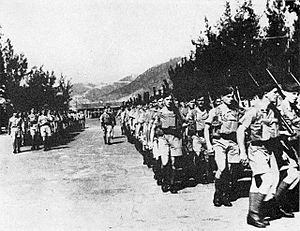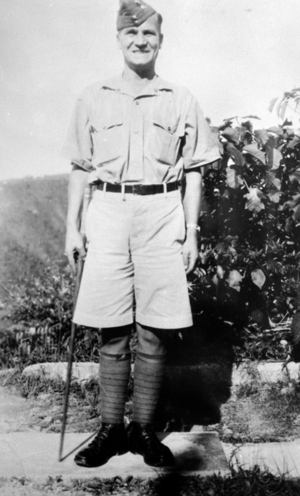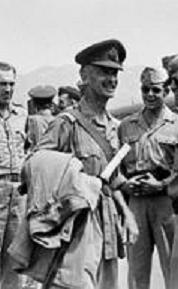C Force facts for kids
Quick facts for kids C Force |
|
|---|---|

The Winnipeg Grenadiers arrive in Hong Kong as part of C Force.
|
|
| Active | 1941 |
| Country | |
| Branch | Canadian Army |
| Type | Composite force |
| Role | Garrison |
| Size | 1,975 personnel |
| Part of | Hong Kong Garrison |
| Garrison/HQ | Hong Kong |
| Engagements | Battle of Hong Kong |
| Commanders | |
| Notable commanders |
John K. Lawson |
C Force was the name given to the Canadian soldiers who fought in the Battle of Hong Kong in December 1941. These brave soldiers were the first Canadians to face Japanese forces in World War II. The main Canadian groups in C Force were the Winnipeg Grenadiers and the Royal Rifles of Canada. They also had a special headquarters unit.
Contents
Why C Force Went to Hong Kong
Japan's Growing Power
In 1941, Japan was becoming very strong and aggressive towards Western countries. In July 1941, Japan took over parts of French Indochina (now Vietnam, Laos, Cambodia). This led the United States, Great Britain, and the Dutch government to stop selling oil to Japan. Japan needed oil for its economy and military. Without it, their country would stop running.
There were talks to solve this problem. But everyone knew Japan might try to take over places like Indonesia, Malaysia, and Burma. These areas had lots of oil and other resources.
A Plan to Stop Japan
Britain wanted to stop Japan from starting a war. They used a plan called "deterrence diplomacy." This meant building up their military forces in Asia. The idea was to make Japan think twice about attacking. They hoped Japan would keep looking for a peaceful solution.
However, Britain was already fighting Germany and Italy in Europe. They didn't have many soldiers to send to Asia. Major-General Arthur Edward Grasett, a Canadian officer, suggested sending more troops to Hong Kong. He thought this would make a "strong psychological stimulus" and scare the Japanese.
Grasett believed Canada could provide two battalions. He knew these troops might not be fully trained. But he argued it didn't matter, as their main job was to deter Japan, not to fight. British leaders like Foreign Secretary Anthony Eden and Prime Minister Winston Churchill agreed. They thought Japan would back down if Hong Kong looked stronger.
Britain also wanted to keep China fighting Japan. They believed that reinforcing Hong Kong would show support for China. This would keep Japan busy in China and prevent them from attacking other British colonies.
Canada's Decision
On September 19, 1941, Britain officially asked Canada for two battalions. They said it would have a "very strong moral effect on the whole of the Far East."
In Canada, the government didn't know much about Hong Kong. They didn't even have a map! The acting Defence Minister, Major Charles Gavan Power, was in charge. He had fought in World War One. Power was popular in Quebec and had many friends and relatives in the Royal Rifles. His own son was also in the Royal Rifles.
Many soldiers in the Royal Rifles were tired of guarding Newfoundland. They wanted to go somewhere more exciting. Power supported their wish to go overseas.
Prime Minister William Lyon Mackenzie King was worried about sending Canadian soldiers into battle. He wanted to avoid a "conscription crisis" like in World War One. Conscription meant forcing people to join the army. This had caused big arguments in Canada before. King wanted to avoid heavy losses that would lead to demands for conscription.
King agreed to send C Force to Hong Kong because he was told there was "no military risk." He believed C Force would only do guard duty. This allowed him to show Canada was helping Britain without risking many lives.
C Force Arrives in Hong Kong
In the fall of 1941, the Canadian government agreed to send two infantry battalions to Hong Kong. This was about 1,975 soldiers. They were expected to do only guard duty, not fight.
The Canadian Army had three classes for units: Class A (best trained) and Class C (least trained). The two battalions chosen were both Class C units. The Royal Rifles of Canada were chosen because of Minister Power's influence. The Winnipeg Grenadiers were chosen to balance things out, with one unit from Eastern Canada and one from Western Canada.
The commander of the Royal Rifles was W.J. Home. The commander of the Winnipeg Grenadiers was L. Col. John Louis Robert Sutcliffe. Brigadier-General John K. Lawson was chosen to lead C Force. He was meant to improve their training.
On October 18, 1941, Japan's prime minister resigned. He was replaced by General Tojo Hideki, a hardliner. This was a sign that Japan was seriously thinking about war.
C Force left Vancouver on October 27 and arrived in Hong Kong on November 16. The ship they were on, HMT Awatea, was a troopship, not a cargo ship. This meant they had to leave most of their vehicles and heavy equipment behind. Only 20 out of 212 vehicles made it. The rest were left in Vancouver.
Unknown to C Force, Japan had already approved plans for war on November 5. Japanese generals were ordered to prepare to invade Hong Kong. During the trip, the Canadian soldiers learned how to use weapons like mortars and grenades.
Life in Hong Kong
When C Force landed in Hong Kong, they were greeted by the governor, Sir Mark Young, and Major-General Christopher Maltby, the top British commander in Hong Kong. The Canadians marched through the city with a British Army band playing music.
C Force was stationed at the Shamshuipo camp. It had comfortable huts but no toilets. Soldiers had servants because it was very cheap. Many soldiers enjoyed the "sophisticated nightlife" of Hong Kong. They found it exciting and different from their homes in Canada.
One soldier, Jeff Marston, wrote home that Hong Kong was a "beautiful city." He loved roller-skating and dancing with Chinese girls. He said it was "marvelous to see the things I have read about in Picture Magazines only to come true before my very eyes."
Soldiers like Company Sergeant Major George McDonell thought they were sent to Hong Kong for training. They expected to go to Europe afterward. Private Maurice D'Avignon wrote that they were ready to fight anywhere for the British Empire.
Major-General Maltby had planned to defend only Hong Kong island. But with the Canadian troops, he decided to also defend the "Gin Drinkers' Line." This was a defensive line on the mainland that separated Hong Kong from China.
On November 30, 1941, Japanese Prime Minister Tojo got permission from the Emperor to go to war. This included plans to attack Hong Kong. On December 3, Maltby and Lawson toured the border. Lawson noted seeing "Japs," while Maltby thought the Japanese soldiers looked "scruffy, lazy and uninterested."
The Battle of Hong Kong
The Japanese attacked Hong Kong on December 7, 1941. C Force was initially placed on the south side of Hong Kong Island. Their job was to stop any Japanese landings from the sea.
On December 8, Japanese planes attacked an empty camp. Two Canadian soldiers were wounded. These were the first Canadian casualties in the Pacific War.
On December 11, the Winnipeg Grenadiers became the first Canadian Army unit to fight in World War II. D Company acted as a rearguard during the retreat from Kowloon. Private John Grey was killed during this time.
The Japanese thought Hong Kong would fall in three days. But the British and Canadian forces fought hard. Major-General Maltby was surprised at how quickly the Japanese broke through the Gin Drinkers' Line. He ordered the Winnipeg Grenadiers to Kowloon.
Fighting on Hong Kong Island
On December 18, 1941, the Japanese landed on Hong Kong Island. A major battle happened on December 19 at Wong Nai Chong Gap. The Winnipeg Grenadiers and the Royal Scots fought fiercely. Major A. B Gresham led a counterattack that pushed the Japanese back.
During this fighting, Company Sergeant Major John Robert Osborn was killed. He was awarded the Victoria Cross, the highest award for bravery. He was the first Canadian to receive this honor in World War Two. The commander of C Force, Brigadier Lawson, was also killed in action. After three days, the Japanese took Wong Nai Chong Gap.
An American officer, Major Reynolds Condon, praised C Force. He wrote that the soldiers showed amazing courage despite having little hope. Many brothers in the Winnipeg Grenadiers were killed during these three days. For example, the Kelso brothers, John and Henry, died near each other. Private Gordon Land and Lance Corporal Roy Land were also killed. Roy Land was captured and killed by Japanese bayonets.
The Royal Rifles of Canada, a French-Canadian unit, first fought on December 19. They were forced to retreat into Stanley village. Company Sergeant Major George McDonell recalled how difficult it was for his "green" (inexperienced) troops. The Japanese were experienced soldiers who had been fighting in China. They would often try to surround the Canadian positions.
Christmas Day Battle
The Royal Rifles faced their toughest fight on Christmas Day. Their commander, Home, was ordered to counterattack and retake parts of Stanley village. He protested, knowing that the British commander, Maltby, was planning to surrender soon. But the attack went ahead to maintain honor.
McDonell remembered his men were "completely exhausted, covered with blood, dirt, wounds." He told them they would attack Stanley village in broad daylight with no support. He thought his men might refuse, but "Not a single man said 'I can't do it.'"
D Company of the Royal Rifles advanced across open ground. The Japanese were not expecting an attack. Fierce hand-to-hand fighting broke out. The Royal Rifles pushed the Japanese back. McDonell's men then fired on the retreating Japanese, causing many losses.
After being defeated, the Japanese attacked a makeshift hospital at St. Stephen's College. They massacred wounded soldiers there. The Royal Rifles suffered 100 casualties in the battle for Stanley village, with 28 killed.
Later that day, the Japanese counterattacked. McDonell's men ran out of ammunition and had to retreat. McDonell stayed behind to cover them. Soon after, news came that Major-General Maltby had surrendered. All soldiers were ordered to lay down their arms.
In the battle for Hong Kong Island, 290 Canadian soldiers were killed. Of these, 130 were from the Grenadiers. Brigadier Lawson, the commander of C Force, was killed. The remaining Canadian soldiers surrendered on Christmas Day.
Awards for Bravery
Soldiers of C Force received 100 awards for their bravery. Here are some of the main awards given:
| Regiment | Decoration/ Award |
No. |
|---|---|---|
| Canadian Auxiliary Service | MBE | 1 |
| Canadian Auxiliary Service | MiD | 1 |
| Canadian Chaplains Service | MC | 1 |
| Canadian Chaplains Service | MiD | 1 |
| Royal Canadian Dental Corps | MiD | 1 |
| Royal Canadian Postal Corps | DCM | 1 |
| Royal Canadian Army Medical Corps | MBE | 3 |
| Royal Canadian Army Medical Corps | ARRC | 2 |
| Royal Canadian Army Medical Corps | MiD | 1 |
| Royal Canadian Corps of Signals | DCM | 1 |
| Royal Canadian Corps of Signals | MM | 1 |
| Royal Canadian Corps of Signals | BEM | 1 |
| Royal Canadian Corps of Signals | MiD | 2 |
| Royal Canadian Ordnance Corps | MM | 1 |
| The Royal Rifles of Canada | DSO | 1 |
| The Royal Rifles of Canada | OBE | 1 |
| The Royal Rifles of Canada | MBE | 2 |
| The Royal Rifles of Canada | MC | 1 |
| The Royal Rifles of Canada | DCM | 1 |
| The Royal Rifles of Canada | MM | 6 |
| The Royal Rifles of Canada | DM | 1 |
| The Royal Rifles of Canada | MiD | 28 |
| The Winnipeg Grenadiers | VC | 1 |
| The Winnipeg Grenadiers | DSO | 1 |
| The Winnipeg Grenadiers | MC | 3 |
| The Winnipeg Grenadiers | DCM | 1 |
| The Winnipeg Grenadiers | MM | 5 |
| The Winnipeg Grenadiers | BEM | 2 |
| The Winnipeg Grenadiers | MiD | 26 |
What the Awards Mean:
- VC - Victoria Cross: The highest award for bravery in battle.
- DSO - Distinguished Service Order: For excellent leadership in battle.
- OBE - Officer of the Most Excellent Order of the British Empire: For a significant role in an activity.
- MBE - Member of the Most Excellent Order of the British Empire: For a positive impact in their work.
- MC - Military Cross: For bravery during active operations.
- ARRC - Associate of the Royal Red Cross: For exceptional nursing service.
- DCM - Distinguished Conduct Medal: For bravery in the field.
- MM - Military Medal: For bravery in battle.
- BEM - British Empire Medal: For outstanding service to the community.
- DM - Dickin Medal: For animals that show bravery in war.
- MiD - Mentioned in Despatches: For brave actions that are noted in official reports.
What Happened Next and Why it Matters
Prisoners of War
After the battle, many Canadians became prisoners of the Japanese. Over the next four years, more Canadians died as prisoners than during the battle itself. Starvation was the main cause of death.
Blame and Controversy
The defeat at Hong Kong caused a lot of debate. Some people tried to find someone to blame. In 1948, Major-General Christopher Maltby, the British commander, wrote a report. He mostly blamed C Force for the defeat. This report was kept secret for a long time.
Some British historians also criticized C Force. They suggested that Hong Kong might have held out longer if C Force had fought better. In Canada, some historians and a documentary also showed C Force in a negative way.
However, many historians have defended C Force. They point out that the Canadians were outnumbered and outgunned. They fought with great determination. The Canadian historian David Franco Marci said C Force "acquitted themselves well" and deserved more praise. He also said Maltby's report was biased because he wanted to avoid blame himself.
Another Canadian historian, Colonel John English, wrote that C Force fought for 17 days in an "impossible struggle." He said they proved Canadian troops were ready to fight hard and die bravely. The American historian Gerhard Weinberg also praised the defense of Hong Kong.
Some Canadians felt that sending C Force was a British attempt to use Canadian troops as "cannon fodder" (meaning they were sent to die). David McIntosh, a Canadian historian, called the Battle of Hong Kong "A British waste of Canadian manpower."
Despite the arguments, many veterans defended their actions. One veteran, Maurice D'Avignon, wrote that the battle proved they were not untrained soldiers. He also believed their fight gave Australia time to get help from England and the USA.
Remembering C Force
The Hong Kong Veterans Association was formed by the Canadian soldiers who survived the battle. In 1991, they planted two maple trees in Hong Kong to remember their friends.
On August 15, 2009, the Hong Kong Memorial Wall was dedicated in Ottawa, Ontario. It honors the 1,977 Canadians who went to Hong Kong in 1941. The names of 961 Royal Rifles and 911 Grenadiers are carved on the wall. The names of 106 members from the Brigade Headquarters are also listed.
A memorial rock with a plaque was also put up. It describes the Canadian role in the defense of Hong Kong. It says they fought with courage against huge odds. It also notes that 290 men died during the battle, and 267 more died as prisoners of war. The memorial states that the Canadians' role "stands as an eloquent expression of their lasting honour."
Images for kids
-
The graves of Pvt J. Maltese of the Winnipeg Grenadiers and Rifleman A. M. Moir of the Royal Rifles of Canada. A battalion from each regiment was sent to Hong Kong in November, 1941, just three weeks before the Japanese invasion. The Canadian contingent was commonly known as "C" Force.





